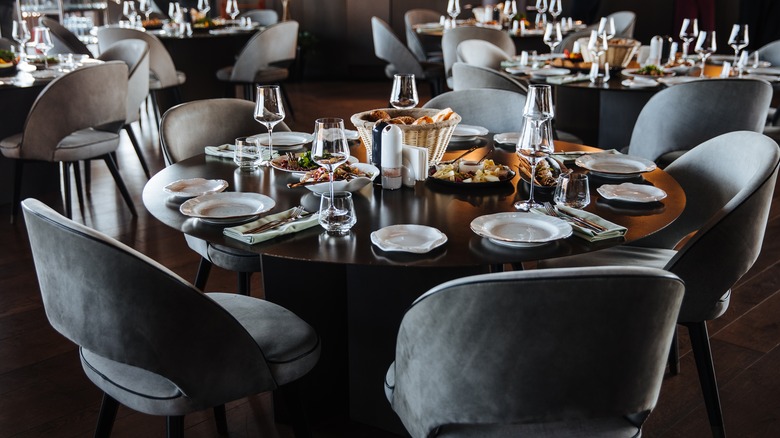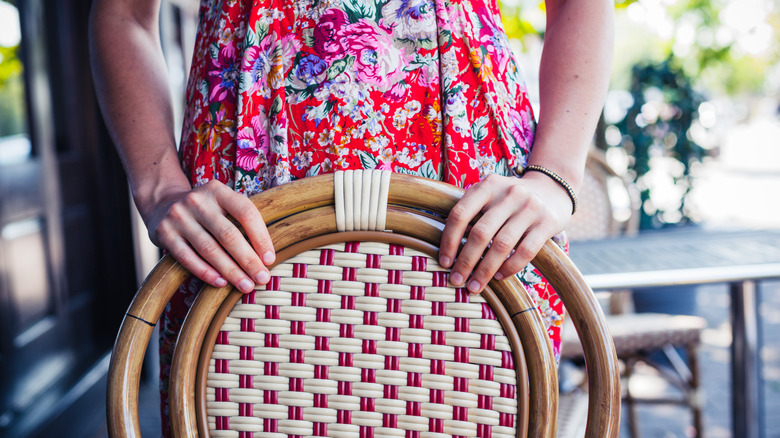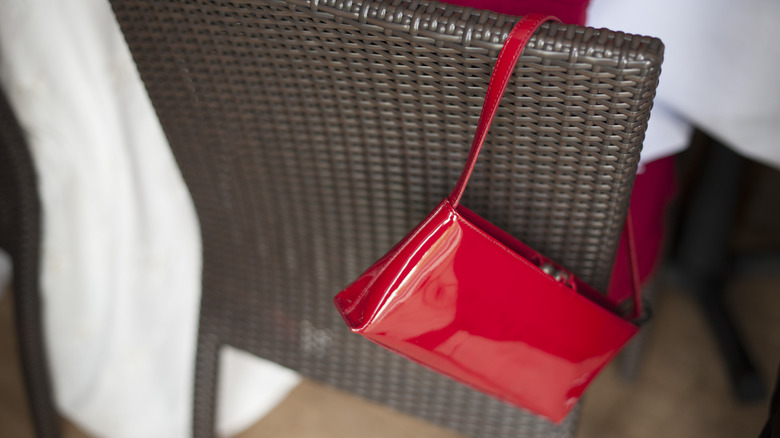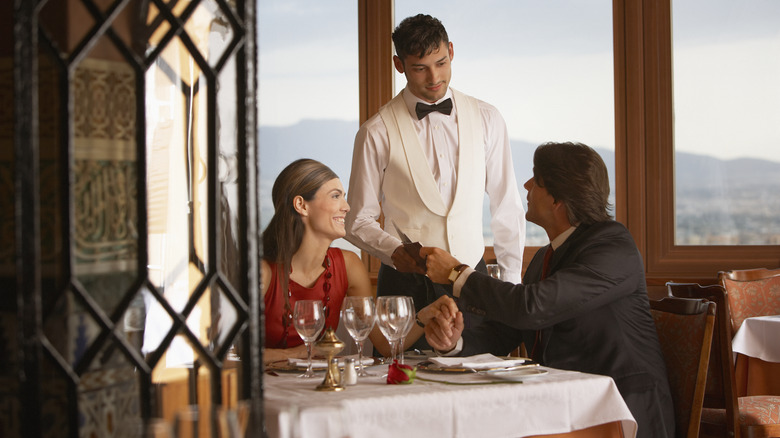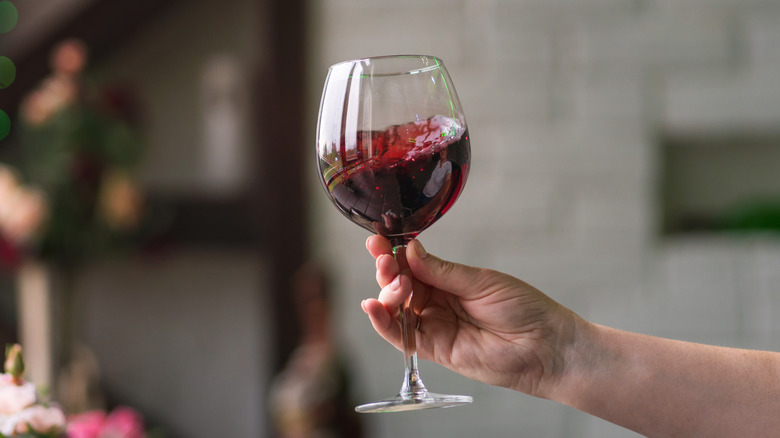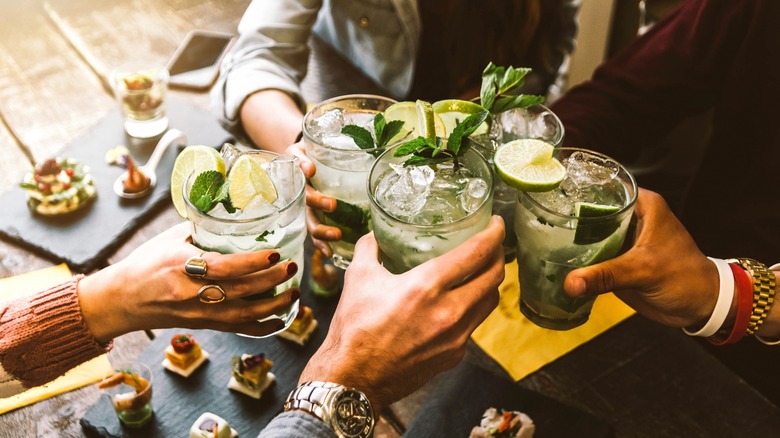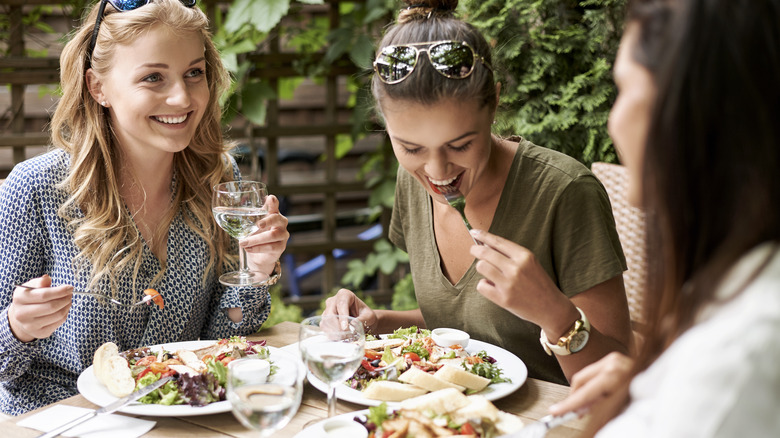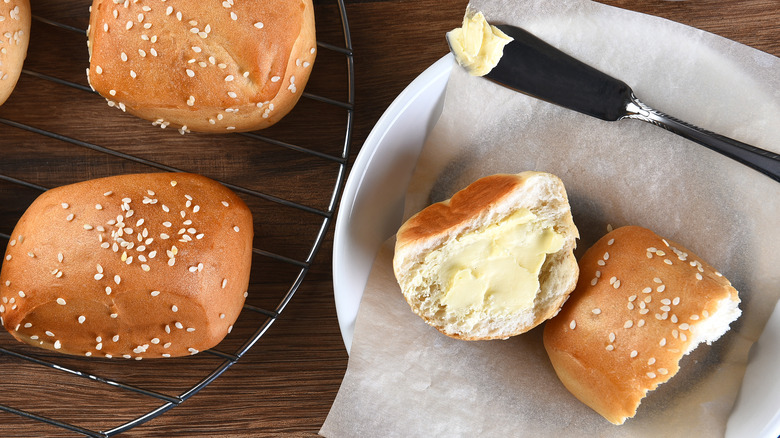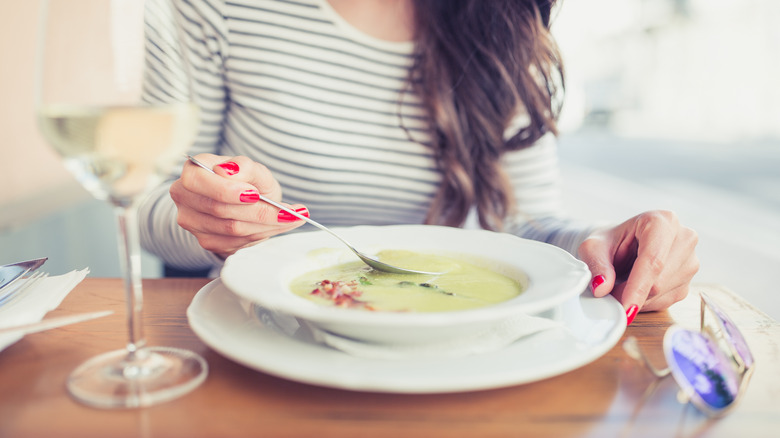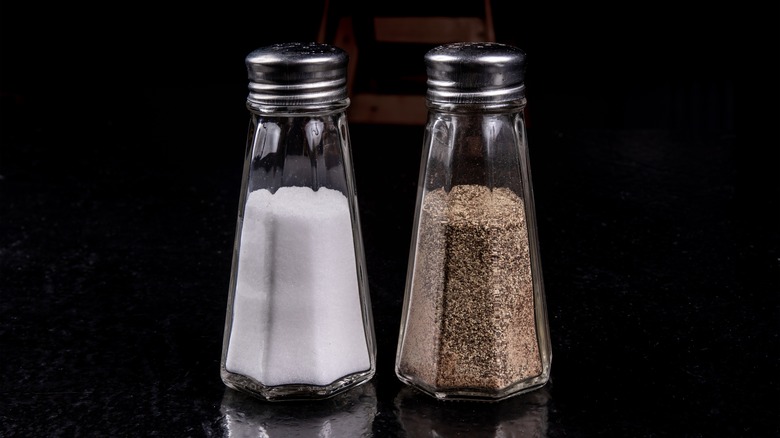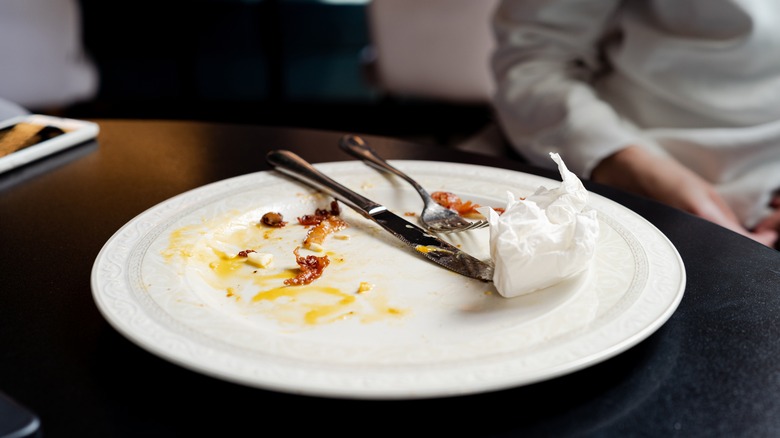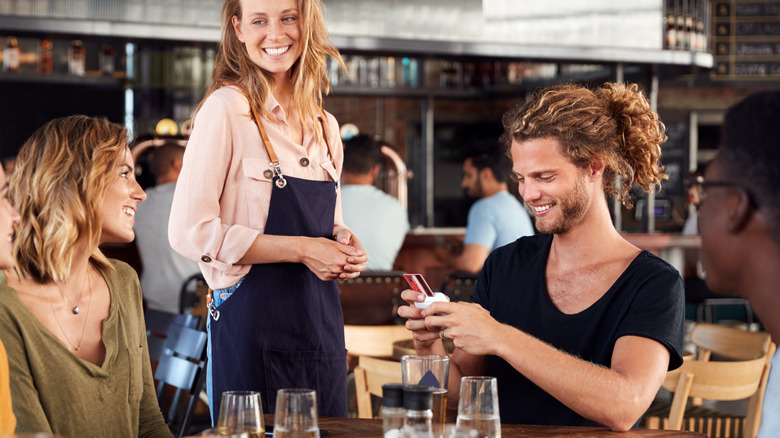Archaic Restaurant Etiquette Rules That Should Be Rewritten
While there have been many rules about etiquette throughout history, most of them are now outdated. For example, who cares if you hang a bag over the back of your chair or what side you approach your chair from? Chances are, nobody. Sure, in a fine dining establishment, you probably want to know which silverware to use with which course, but really, many of history's etiquette rules are obsolete. Considering our modern version of etiquette originated in the French courts, where it was meant to be elitist and exclusionary, it isn't a huge shock that they aren't as relevant as they once were.
Every culture has a system of manners that helps them coexist and show respect, but etiquette is another thing entirely. This article explores archaic restaurant etiquette rules that should be rewritten, and in many cases, have been. Keep up to date so you can sit back, relax, and enjoy your next restaurant visit instead of getting caught up in all the what-to-do details.
Turn off phones before a meal
Turning off your phone or even refraining from using your phone entirely in a restaurant is no longer required or expected. Many people leave their phones on the table while they are eating. After all, going to a restaurant is often a social activity, and our phones are a hub for social interactions. For most people, it is difficult to disconnect from their phones entirely, especially if they have children or are meeting someone for a meal during typical work hours.
Posting pictures on social media about what you're eating, where you are, or who you're with is a common practice — none of which can be accomplished when your phone is powered down. As a result of our changing culture and society, classic phone etiquette rules have become seriously outmoded.
Sure, many people think using your phone excessively during a meal is rude or bad manners, but manners and etiquette are different. As long as you restrict your screen time during shared meals, are present, and you're engaged with the people you are with, no one will have a problem with you occasionally using your phone.
Always approach your chair from the left side and get up on the right
One lesser-known etiquette rule is that you should always approach your chair from the left side and get up from the right side. The purpose of this rule is to help you avoid colliding with other members of your party when sitting or standing. However, in reality, no one cares or even notices which side of the chair you approach from. There is even some discrepancy about this rule, further complicating the procedure. Some people believe you should both approach and exit from the right. Does it really matter, though?
Just try not to bump into the people on either side of your seat — which is actually quite simple — and you should be fine. In modern times, it seems silly to assess a person's table manners before a meal has even started, right? If someone wants to judge you poorly based on how you take a seat, that's their issue, not yours.
Never hang a purse or handbag over the back of your chair
Etiquette expert Joy Weaver has been credited with saying you should never hang a handbag on the back of your chair while seated. Instead, she recommends placing your purse on the floor next to your chair on the right-hand side. However, this rule is mainly unfollowed and overly restrictive. One of the reasons this formal etiquette rule is so unreasonable is that it forces you to get the bottom of your bag dirty — and if you have a nice bag, the floor is probably the last place you want it to be.
If you think about it, placing your bag on the floor also creates an unnecessary tripping hazard for the people seated beside you and the server. So, if you want to hang your handbag or purse on the back of your chair, go for it! Many tables and bar seats now have hooks for bags, too, further proof of this formal etiquette rule being outworn.
Don't order drinks before everyone in your group arrives
Due to formal etiquette rules, some people believe ordering drinks before every member of your party is present is considered rude, but many manners experts disagree. Ordering drinks when the server asks is fine, even if you are still waiting on some guests to arrive (via Etiquette Scholar). This may be a common misconception stemming from the similar etiquette rule that says it is rude to start eating before everyone has their plate. Regardless of how it started, it can be overlooked without consequence.
So, if your friends are late or you show up early, and you want a drink, order one. In fact, in a restaurant, it is actually rude to the server to sit at their table and not order anything. We're not saying you should get drunk or have more than one drink before everyone joins you, but no one is going to fault you for enjoying a beverage while you wait.
A man must stand to greet a woman, but not other men
Traditionally, formal etiquette rules claimed a man should stand to greet a woman, and not another man. As you may have guessed, this is completely old-fashioned. Both men and women should stand to greet a person of any gender. According to Maralee McKee, a well-known etiquette expert, standing to greet someone gives you points in your favor before you even say anything. She says this is because your actions express you are welcoming. Mckee also points out that standing to greet someone shows you noticed them and that they are worth the effort needed to stand. Therefore, in a formal situation, everyone should stand to greet everyone. If you're simply meeting old friends or family for a meal, you can probably skip standing up unless you want to give them a hug.
In addition, formal etiquette used to say it was improper to shake a woman's hand unless she offered first. Now, this can be seen as condescending. One of the only exceptions to this rule could be devout Muslim women, who often prefer not to be greeted by men this way.
One part of the menu must always be touching the table, but keep your elbows off
Another fine dining etiquette rule is always holding the menu with one corner or portion maintaining contact with the table. This means you aren't supposed to hold the menu up and entirely off the table, even if you are trying to get a better look. The idea behind this ritual most likely stems from a desire to stay present and not hide your face. Even so, most people view this as an unnecessary rule just for the sake of having rules. Or, as they say, etiquette for etiquette's sake. And it certainly doesn't imply bad manners in a casual dining environment.
Keeping your elbows off the table is another standard etiquette rule with a long history. While the reasons behind it may have changed over time, it is thought to have originated in the Middle Ages when tables were highly unstable, and one wrong touch could send them toppling to the ground. Of course, nowadays, tables are much more stable and can withstand elbows and movement without issue. Even by etiquette standards, placing your elbows on the table has become acceptable behavior between courses. Resting your elbows on the table to lean forward shows engagement in conversation, and it can also be used as a way to reach across the table and hold hands as a sign of affection.
Don't swirl and sniff your wine, and always drink from the same spot
In fine dining establishments, ordering wine comes with several etiquette rules. For example, some people view swirling and sniffing wine repeatedly as rude, especially if there is a sommelier. However, many diners have plenty of wine knowledge and are equipped to enjoy their drink any way they like. As long as you don't make a show of swirling and use it to aerate the wine as intended, no one will care how you consume your drink, the sommelier included.
Once you have your drink, many etiquette experts also claim you have to drink from the same spot on your glass with every sip. This helps you avoid leaving behind more "unsightly" smudges than necessary. Whether it is from lip gloss, lipstick, or your body's natural oils, leaving marks on the rim is likely to happen, so don't worry about this mundane detail. Just enjoy your drink, meal, and company, and no one will even notice how many marks are on the rim of your glass.
Don't clink your glasses to cheers
This may seem a bit contradictory to the elements of toasting, but an old fine dining rule of etiquette insists you should not clink your glasses together when you say cheers. Supposedly clinking drinks draws unnecessary attention — and in fine dining establishments making as little noise as possible has traditionally been considered the most polite course of action. In addition, touching glasses can damage thinner glassware, which, of course, is frowned upon.
Fortunately, this rule has essentially become irrelevant. You do not need to be so quiet that no one knows you are there, and if the moment calls for celebration, there's no need to hesitate. Or, if you want to post a celebratory boomerang of you clinking drinks with friends on your social media story, don't feel like you have to hold back. We aren't saying you should stand and cheer loudly regardless of your surroundings or bang your glasses together so forcefully that they might break, but touching them together for a toast is absolutely acceptable. Many people even view not touching glasses after a toast as bad luck.
Toasting requires drinking alcohol
An old superstition originating in Greek Mythology claims you should never make a toast with water in your glass because it inadvertently wishes bad luck. It comes from the tradition of toasting the dead with water but has carried over into formal etiquette rules. However, it is just a superstition and shouldn't be taken too seriously. Finding an etiquette expert that still agrees with this outdated custom is also relatively uncommon.
In contemporary times, anyone can make a toast, and they can do it with any drink they like. If you are abstaining from alcohol or choosing not to partake for any reason, there is no purpose for you to feel excluded or exempt from making a toast yourself. Feel free to cheers with friends while drinking juice, coffee, tea, water, or whatever you prefer. If you are somewhat superstitious and don't want to tempt fate, you can always make a toast, cheers, and then hold your glass to your mouth without taking an actual drink. Just keep in mind that some people find that to be bad luck as well.
Parallel ordering is a must
Ordering the same number of courses as the other members of your party is another etiquette rule considered to be part of the past. Essentially, this means you're not supposed to order a soup, salad, or appetizer course unless everyone at the table does too. Initially, this rule was established to ensure other people at the table were not watching you eat while waiting for the next part of their meal.
Parallel ordering also used to be expected by some fine dining restaurants as a way to facilitate smooth, uninterrupted service, but that is not the case anymore. You should feel comfortable ordering salad, soup, or appetizers whether your friends do or not. You won't offend the servers or complicate things in any significant way, and they are fully capable of accommodating your needs and preferences. As for your friends or dinner guests, they are unlikely to mind either. If no one else orders an appetizer, you can always share. Although, offering to share your soup could be somewhat awkward unless you are really close with them!
Always tear small bites off bread and only butter one bite at a time
Eating from a piece of bread without tearing a bite-sized piece off or buttering an entire slice or roll at one time was considered rude. It also used to be seen as bad form to hold your roll or slice of bread while buttering. Instead, you were meant to leave it on the plate while buttering and only lift a bite-size piece to your mouth when you're ready to consume.
To further complicate the matter, some etiquette experts, like Maggie Oldham, say you shouldn't enjoy bread placed on the table before the first course is served at a business or formal dinner. That's just torture, though. For the most part, it doesn't really matter how or when you eat your bread as long as you don't eat like a slob and take more than your share. Again, this is an etiquette rule made purely for the sake of etiquette — no one will be watching you that closely or care if you enjoy your bread a different way.
There's only one right way to eat soup
Soup is often seen as one of the trickier foods to eat in a fine dining restaurant because it comes with a whole set of etiquette rules, but it doesn't have to be that way. Many of the guidelines are unnecessary, and most people don't even know what they are, at least not precisely. You should hold a soup spoon between your middle finger and thumb and dip it into the bowl near the edge in a sideways direction (per Etiquette Scholar). Then, you should slowly skim the contents starting at the front of the bowl and ending near the back. Also, drink from the side of the spoon and avoid slurping. Let's get serious, though: Who has time to monitor how you are holding your spoon or in which direction you are moving it in your bowl? Just enjoy your soup, and everything will be fine.
Even though it might be tempting, formal etiquette also views blowing on your soup to help it cool quickly as forbidden. Instead, you are supposed to gently stir the soup to help it gradually release heat. This rule still stands in a formal restaurant or business setting, but when having a casual meal with friends, it may not be as important. Sure, you don't want to blow your germs all over everyone else's food, but you can still blow gently on your spoon without interfering with your neighbors at the table.
Always pass the salt and pepper together
Formal etiquette even has rules for passing the salt and pepper, which seems a bit like overkill. According to traditional standards, the salt and pepper shakers should never be separated, and you should always pass them together. You should also pass them to the right and place them on the table, not in someone's hand. Apparently, they are like a couple, and they should never be separated from one another. Even if someone only asks for one, pass both. Since most people don't even know about this rule, it is fair to say it is not standard or expected. Therefore, if you don't pass both shakers together or hand them off instead of putting them down, there's a good chance no one will be the wiser.
One etiquette rule adjacent to this that still stands is to refrain from adding salt or pepper to your dish before trying at least one bite. This can be seen as an insult to the chef. Even so, you are the only person who knows how you like your food. Don't be embarrassed to add whatever seasonings you want, including hot sauce or any other condiment.
Silverware signals
While some people still follow silverware position signals, it is no longer a sign of bad manners if you don't. Placing your silverware together across your plate, pointing up toward 11 or 12 o'clock means you are finished enjoying your plate. An inverted V position also signals you are resting and not ready for your plate to be removed. However, even in fine dining restaurants, your server will simply ask whether you are done with a plate or not, eliminating the need to remember unnecessary etiquette rules. After all, it's okay to communicate with your server; there's no need to treat them like "the help."
Napkin etiquette also says you should keep it in your lap until you are ready to leave the table. When the time comes, etiquette rules go so far as to say your napkin should be placed on the left side of your plate if it is still on the table. This is unnecessarily restrictive, though, and you won't offend the other members of your party if you take your napkin off your lap after you are done eating.
Men should always pay for women
Last up on our list of archaic restaurant etiquette rules that should be rewritten is men should always pay for women. In the past, women weren't allowed to make and retain their own money. Women weren't permitted to open personal bank accounts or have their own credit cards or mortgages either. As a result, it was commonly accepted that men should always pay for women when dining out. If a woman offered to settle the bill on a date, it could even be considered rude and condescending.
Women's financial standing has changed significantly over time, so this etiquette rule is now out of style. Women are more than capable of paying for themselves. Instead, etiquette expert Emily Post says whoever extends the invitation should pay for the meal. Sure, some women like it when men pay, especially on a first date, but it is not mandatory. Men should also forget about ordering for women. While it was once viewed as gentlemanly, it comes off as more controlling now.

